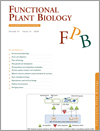
Functional Plant Biology
Volume 47 Number 10 2020
Salinity is an environmental stress factor that limits plant growth, development and survival. Numerous studies have indicated that a signalling molecule, nitric oxide (NO), can mitigate the negative effects of salt stress. NO improves water management, ionic homeostasis, metabolic processes and prevents damages caused by reactive oxygen species (ROS). It is believed that NO may interact with plant growth and development regulators – polyamines – in inducing salt stress tolerance in plants.
Arbuscular mycorrhizal fungi forms symbiotic association with more than 80% of terrestrial plants, conferring additional advantage of mycorrhiza induced resistance. The present review summarises underlying molecular mechanisms of mycorrhiza induced resistance at the phytohormone, metabolite and rhizospheric levels. Further scope and controversies in the field of mycorrhiza induced resistance are discussed.
FP19364Alteration in plant spacing improves submergence tolerance in Sub1 and non-Sub1 rice (cv. IR64) by better light interception and effective carbohydrate utilisation under stress
 , Mohammad Shahid, Rahul Tripathi, Rashmita Behera, Sudhanshu Singh and Ashish K. Srivastava
, Mohammad Shahid, Rahul Tripathi, Rashmita Behera, Sudhanshu Singh and Ashish K. Srivastava
Occasional flooding has been a problem for rice growers around the world. The effect of crop spacing for physiological recovery of plants after imposing submergence stress was investigated, where wider spacing revealed better survival owing to carbohydrate reserve especially for submergence intolerant rice cultivar. Closer spaced plants depleted carbohydrate reserve faster, leading to early senescence and damage to leaf tissues, hence had lesser survival. This implies crop management strategy has a prominent role improving the tolerance of rice plants facing submergence stress.
FP19101Global convergence in the balance between leaf water supply and demand across vascular land plants
Modern angiosperms have greater photosynthetic capacity than earlier plant lineages but the adaptations allowing this are under investigation. We found that leaf vein density (water supply) and stomatal density (water demand) are globally coordinated across vascular land plants and that the advantage of modern angiosperms is associated with the emergence of xylem with low intraconduit resistance and leaves with high vein and stomata densities. This probably enhanced their productivity and adaptability to changing climates.
FP19303Early effects of salt stress on the physiological and oxidative status of the halophyte Lobularia maritima

Recently, several genes with proven influence on salt tolerance have been isolated from the Mediterranean halophyte Lobularia maritima. We characterise L. maritima’s response to increasing NaCl concentrations (0–400 mM) at the physiological, biochemical and molecular levels. We show that L. maritima is a salt-includer halophyte that can rapidly develop physiological and antioxidant mechanisms to adapt to salt and manage the oxidative stress induced by high salt concentrations.
FP19331NAC transcription factor involves in regulating bacterial wilt resistance in potato
Overexpression of StNACb4 gene can enhance the tolerance of tobacco to R. solanacearum and can induce cell death and callose deposition in tobacco. The upregulated expression of StNACb4 can also activate the expression of StPR10 gene. Our results provide important new insights into the regulatory mechanisms of bacterial wilt resistance in potato.
FP19345Proteomic profiling uncovered the cytosolic superoxide dismutase BsSOD1 associated with plant defence in the herbal orchid Bletilla striata
 , Liang-Jing Cao, Yong-Jian Yang, Peng-Ming Liu, Xuan Wang, Bao-Liang Yang, Yu-Lei Zhang, Yan-Feng Ding and Jun Liu
, Liang-Jing Cao, Yong-Jian Yang, Peng-Ming Liu, Xuan Wang, Bao-Liang Yang, Yu-Lei Zhang, Yan-Feng Ding and Jun Liu 
Antioxidation plays an important role in plant defence. We profiled the proteomes of te resistant and susceptible strains of the herbal orchid Bletilla striata and identified the superoxide dismutase BsSOD1 as an antioxidation-related protein localised in the cytoplasm. Our study helps to understand the molecular mechanism of the plant defence system and may lead to development of biological protection strategies for cultivation.
We combined transcriptome data and a series of experiments to identify genes related to the production of floral aroma in Osmanthus without genome sequencing. The transcriptome data revealed the genes related to the 2-C-methylerythritol-4-phosphate pathway (MEP) pathway in O. fragrans, a quantitative real-time PCR (qRT-PCR) assay confirmed that terpene synthase (TPS) gene is crucial for the MEP pathway. The O. fragrans TPS gene family was screened and two monoterpenoid synthase enzymes were identified based on the expression level, qRT-PCR and a series of experiments.



